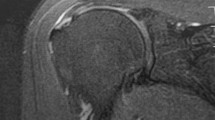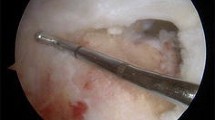Abstract
Purpose
To compare failure rates and outcomes after transosseous equivalent (TOE) double row (DR) knotted suture bridge versus knotless suture tape bridge repair techniques for rotator cuff tears.
Methods
A consecutive series of 272 shoulders in 256 patients who underwent arthroscopic, double row, TOE repair for full-thickness tears of the supraspinatus tendon were reviewed. Eighty-four shoulders were repaired using knotted suture bridge (KSB) technique, and 188 shoulders were repaired using all knotless suture tape bridge (KTB) technique. Revision procedures and concomitant subscapularis tendon repairs were excluded from analysis. The minimum follow-up was 12 months. Primary outcome was failure of surgical repair, defined as either confirmed retear on MRI and/or need for revision surgery. Secondary clinical outcome measures were assessed including range of motion, strength, visual analog scale (VAS), operative time, subjective shoulder value (SSV), Patient-Reported Outcomes Measurement Information System (PROMIS) mental and physical health, American Shoulder and Elbow Surgeons Shoulder Score (ASES), Brophy shoulder activity scores, and need for manipulation under anesthesia (MUA).
Results
A total of 127 shoulders (38 KSB and 89 KTB) met inclusion criteria for the study. No significant difference in demographic variables were present between the groups at baseline. Supraspinatus tear size and average follow-up time did not differ significantly between groups. Failure rates were similar between the KSB and KTB repairs (13.1 vs 7.9%, n.s.). There was no significant difference in functional outcomes including strength, range of motion in forward flexion and external rotation, as well as patient reported outcomes including VAS, SSV, PROMIS, ASES, and Brophy scores between the groups. There was also no difference in post-operative stiffness requiring MUA.
Conclusion
Both KSB and KTB repair techniques demonstrate low retear rates with excellent functional outcomes when compared to pre-operative examination. Both KSB and KTB techniques are viable options for achieving a successful rotator cuff repair.
Level of evidence
Level III

Similar content being viewed by others
References
Bedeir YH, Schumaier AP, Abu-Sheasha G, Grawe BM (2019) Type 2 retear after arthroscopic single-row, double-row and suture bridge rotator cuff repair: a systematic review. Eur J Orthop Surg Traumatol 29:373–382
Day Hazra RO, Ernat JJ, Rakowski DR, Boykin RE, Millett PJ (2021) The Evolution of arthroscopic rotator cuff repair. Orthop J Sport Med 9:1–13
Fuchs B, Weishaupt D, Zanetti M, Hodler J, Gerber C (1999) Fatty degeneration of the muscles of the rotator cuff: assessment by computed tomography versus magnetic resonance imaging. J Shoulder Elbow Surg 8:599–605
Honda H, Gotoh M, Mitsui Y, Nakamura H, Tanesue R, Shimokobe H, Shiba N (2018) Clinical and structural outcomes after arthroscopic rotator cuff repair: a comparison between suture bridge techniques with or without medial knot tying. J Orthop Surg Res 13:297
Hug K, Gerhardt C, Haneveld H, Scheibel M (2015) Arthroscopic knotless-anchor rotator cuff repair: a clinical and radiological evaluation. Knee Surg Sport Traumatol Arthrosc 23:2628–2634
Iannotti JP, Deutsch A, Green A, Rudicel S, Christensen J, Marraffino S, Rodeo S (2013) Time to failure after rotator cuff repair: a prospective imaging study. J Bone Joint Surg 95:965–971
Kim KC, Shin HD, Lee WY, Yeon KW, Han SC (2018) Clinical outcomes and repair integrity of arthroscopic rotator cuff repair using suture-bridge technique with or without medial tying: prospective comparative study. J Orthop Surg Res 13:1–8
Kunze KN, Rossi LA, Beletsky A, Chahla J (2020) Does the use of knotted versus knotless transosseous equivalent rotator cuff repair technique influence the incidence of retears? A systematic review. Arthroscopy 36:1738–1746
Longo UG, Carnevale A, Piergentili I, Berton A, Candela V, Schena E, Denaro V (2021) Retear rates after rotator cuff surgery: a systematic review and meta-analysis. BMC Musculoskelet Disord 22:1–14. https://doi.org/10.1186/s12891-021-04634-6
Mandaleson A (2021) Re-tears after rotator cuff repair: current concepts review. J Clin Orthop Trauma 19:168–174
Mijares MR, Hiller A, Alhandi A, Kaimrajh D, Milne T, Latta L, Baraga MG (2020) Is it necessary to tie the medial row in rotator cuff repair double-row constructs when using suture tape? J Clin Orthop Trauma 11:S378–S382
Millett PJ, Espinoza C, Horan MP, Ho CP, Warth RJ, Dornan GJ, Katthagen JC (2017) Predictors of outcomes after arthroscopic transosseous equivalent rotator cuff repair in 155 cases: a propensity score weighted analysis of knotted and knotless self-reinforcing repair techniques at a minimum of 2 years. Arch Orthop Trauma Surg 137:1399–1408
Nemirov D, Herman Z, Paul RW, Clements A, Beucherie M, Brutico J, Hadley CJ, Ciccotti MG, Freedman KB, Erickson BJ, Hammoud S, Bishop ME (2022) Knotted versus knotless medial-row transosseous-equivalent double-row rotator cuff repairs have similar clinical and functional outcomes. Arthrosc Sport Med Rehabil 4:e381–e386
Park MC, Elattrache NS, Ahmad CS, Tibone JE (2006) “Transosseous-equivalent” rotator cuff repair technique. Arthroscopy 22:1360.e1–5
Park MC, ElAttrache NS, Tibone JE, Ahmad CS, Jun BJ, Lee TQ (2007) Part I: footprint contact characteristics for a transosseous-equivalent rotator cuff repair technique compared with a double-row repair technique. J Shoulder Elbow Surg 16:461–468
Park MC, Tibone JE, ElAttrache NS, Ahmad CS, Jun BJ, Lee TQ (2007) Part II: biomechanical assessment for a footprint-restoring transosseous-equivalent rotator cuff repair technique compared with a double-row repair technique. J Shoulder Elbow Surg 16:469–476
Prabhakar A, Kanthalu Subramanian JN, Swathikaa P, Kumareswaran SI, Subramanian KN (2022) Current concepts on management of cuff tear. J Clin Orthop Trauma 28:101808
Rossi LA, Rodeo SA, Chahla J, Ranalletta M (2019) Current concepts in rotator cuff repair techniques: biomechanical, functional, and structural outcomes. Orthop J Sport Med 7:1–8
Şahin K, Şentürk F, Ersin M, Arzu U, Chodza M, Erşen A (2021) Repair integrity and functional outcomes between knot-tying and knotless suture-bridge arthroscopic rotator cuff repair: a prospective randomized clinical trial. Orthop J Sport Med 9:1–12
Sano H, Tokunaga M, Noguchi M, Inawashiro T, Irie T, Abe H, ToshimitsuYokobori A (2017) Tight medial knot tying may increase retearing risk after transosseous equivalent repair of rotator cuff tendon. Biomed Mater Eng 28:267–277
Shigley C, Green A (2022) Shoulder conditions and health related quality of life and utility: a current concepts review. JSES Int 6:167–174
Takeuchi Y, Sugaya H, Takahashi N, Matsuki K, Tokai M, Morioka T, Ueda Y, Hoshika S (2020) Repair integrity and retear pattern after arthroscopic medial knot-tying after suture-bridge lateral row rotator cuff repair. Am J Sports Med 48:2510–2517
Funding
No funding was disclosed by the author(s).
Author information
Authors and Affiliations
Contributions
MAF: significant contribution to data collection, manuscript preparation, statistical analysis, and conception of design. Reviewed and provided final approval for version to be published, and is agreeable to be accountable for all aspects of the work. JDH: significant contribution to manuscript preparation, and intellectual content. Reviewed and provided final approval for version to be published, and is agreeable to be accountable for all aspects of the work. NPD: significant contribution to data collection and manuscript preparation. Reviewed and provided final approval for version to be published, and is agreeable to be accountable for all aspects of the work. NW: significant contribution to data collection. Reviewed and provided final approval for version to be published, and is agreeable to be accountable for all aspects of the work. NP: significant contribution to manuscript preparation, and intellectual content. Reviewed and provided final approval for version to be published, and is agreeable to be accountable for all aspects of the work. EN: significant contribution to data collection. Reviewed and provided final approval for version to be published, and is agreeable to be accountable for all aspects of the work. AP: significant contribution to manuscript preparation, and intellectual content. Reviewed and provided final approval for version to be published, and is agreeable to be accountable for all aspects of the work. SS: significant contribution to manuscript preparation, statistical analysis, and intellectual content. Reviewed and provided final approval for version to be published, and is agreeable to be accountable for all aspects of the work. BPL: significant contribution to conception of design, manuscript preparation, statistical analysis, and intellectual content. Reviewed and provided final approval for version to be published, and is agreeable to be accountable for all aspects of the work. AL: significant contribution to conception of design, manuscript preparation, statistical analysis, and intellectual content. Reviewed and provided final approval for version to be published, and is agreeable to be accountable for all aspects of the work.
Corresponding author
Ethics declarations
Conflict of interest
The authors, their immediate families, and any research foundation with which they are affiliated did not receive any financial payments or other benefits from any commercial entity related to the subject of this article.
Ethical approval
This study was approved by the local ethical committee (University of Pittsburgh Institutional Review Board; STUDY20030061).
Informed consent
Not applicable for this retrospective study.
Additional information
Publisher's Note
Springer Nature remains neutral with regard to jurisdictional claims in published maps and institutional affiliations.
Supplementary Information
Below is the link to the electronic supplementary material.
Rights and permissions
Springer Nature or its licensor holds exclusive rights to this article under a publishing agreement with the author(s) or other rightsholder(s); author self-archiving of the accepted manuscript version of this article is solely governed by the terms of such publishing agreement and applicable law.
About this article
Cite this article
Fox, M.A., Hughes, J.D., Drain, N.P. et al. Knotted and knotless double row transosseous equivalent repair techniques for arthroscopic rotator cuff repair demonstrate comparable post-operative outcomes. Knee Surg Sports Traumatol Arthrosc 31, 1919–1924 (2023). https://doi.org/10.1007/s00167-022-07121-0
Received:
Accepted:
Published:
Issue Date:
DOI: https://doi.org/10.1007/s00167-022-07121-0




